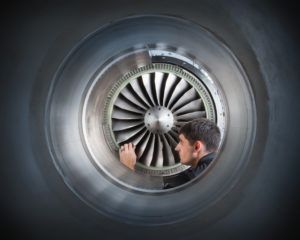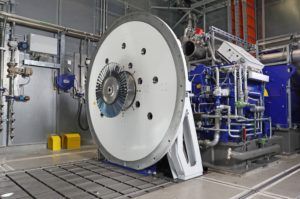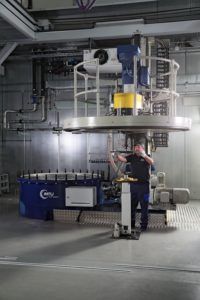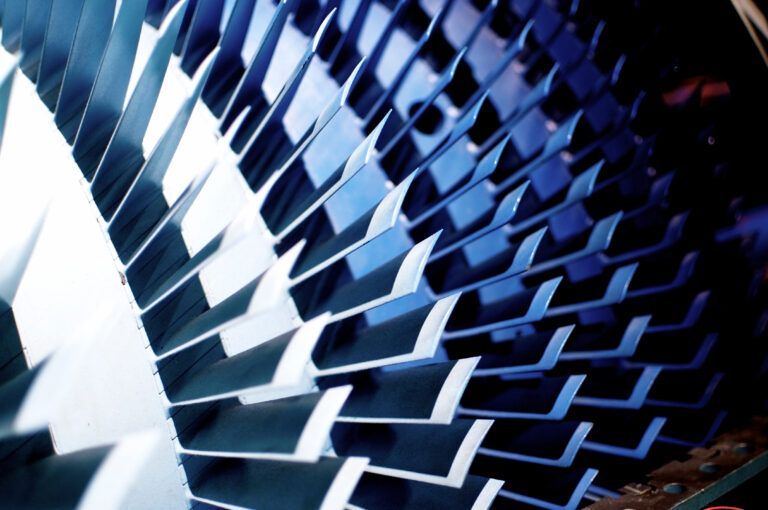Words by Rob Coppinger
With the increasing pressure of more environmentally friendly aviation and the drive to reduce fuel burn, investments are being made in facilities to advance the efficiency of gas turbines. From the mid-west of the USA to Belgium and Germany, efforts are underway to improve the function of key sections of the aero engine, particularly the compressors which increase air pressure to achieve effective combustion.
In Liège, Belgium a new 3,000 square metre (32,300 square foot) facility is expected to be commissioned at the end of 2023. Available to companies, research centres and universities, the Banc d’Essais de COmpresseurs Valorisant l’Environnement et la Recherche, or BeCOVER, is a €50 million (US$53 million) investment by the Société Régionale dʼInvestissement de Wallonie, Société Fédérale de Participations et d’Investissement and Safran Aero Boosters. It is a public, private partnership.
“The sustainability of our industry depends on new environmentally friendly technologies, and we are preparing for this. That’s why we decided to invest in this project, despite the temporarily difficult situation the sector is experiencing due to Covid,” said Safran Aero Boosters’ CEO, François Lepot. “Thanks to BeCOVER, Belgium has a unique testing facility to develop next-generation compressors.”

German company MTU Aero Engines opened a new center in 2019 for testing the component parts for compressors such as blades and vanes, disks, casings, rings and tubing. Testing at the German Aerospace Center’s (DLR) Cologne site has also been undertaken by MTU alongside partners from an EU Clean Sky 2 program project. The Inter Compressor Duct (ICD) rig was operational in 2018 and 2019 to test three different ICD configurations. From two of those configurations a design was chosen for the compressor research which promised the best compromise out of robust operational behavior and best engine performance. The DLR rig is in a dual spool configuration. MTU stated that the integration of the two-spool configuration in the testbed was the challenging part. An advantage of having twin spools rather than a single spool is that the rotor speed better matches the airflow. Each compressor segment is driven by its corresponding turbine using two separate driveshafts, with one inside the other. This impacts the rig design and its entire operation.
Next year MTU will update its own two-shaft test rig for increased performance and complexity requirements. MTU’s approach to modernizing its facilities is to create a highly integrated, automated testbed. The company has been investing in new technologies capable of realizing the test program’s objectives for modern compressors. Highly accurate measurements are required and are taken in a harsh environment. Testing compressors means handling a high energy device. The compressor is operated to the very edge of its operating range, and sometimes beyond, but must be run safely.
This is a challenge for the instrumentation and the integrity of the testbed’s operation and its automation. According to MTU, it requires an “extraordinary level of expertise” from the test crew.
The designs of new compressor generations will need to have high efficiency requirements and at the same time ensure robust operational behavior within the flight envelope of the aircraft. Smart devices for facility control, a high degree of automation and advanced measurement techniques for collecting high precision data have been key MTU investments.
“There is a continuous need to introduce the latest technology,” said the company. “And this all needs to be integrated, resulting in a highly digitalized test bed environment supporting the acquisition, consolidation and analysis of all the data.”
The calibration of analytical design tools is a priority for any testbed, the scope of compressor testing depends on it. For testing compressors, the proof of performance, efficiency and operability of the components and the mechanical integrity of the compressor module are paramount.
Closing the gap

BeCOVER, or Test Cell for Compressors Enhancing the Environment and Research will be capable of testing all types of compressors for the latest civil and military aircraft engines. A gap in testing is the availability of test cells that will be able to test the new generation of compressors. The facility will have a 30MW electrical supply for larger compressors that have a shaft for the low and high compressors. Other European test cells operate at only 16MW.
Just as BeCOVER is being built to develop compressors for more environmentally friendly engines, the facility itself is intended to be greener. As well as its earthen cover that makes it a semi-buried building to minimize its noise pollution, the facility will collect rainwater and use that for cooling and other purposes.
The key capability for BeCOVER is its closed loop testing which enables testing at altitude conditions. The test cell will also be able to test triple airflows. Normally a compressor has one or two air flows, but within the next generation of engines, especially for military applications there will be triple flow conditions in the turbine. The measurement of the three airflows from the exit of the compressor will also help determine the compressors performance.
A research and technology compressor will be the subject of BeCOVER’s first test program, which is planned to be underway at the start of 2024.
“What is really innovative for BeCOVER is that the facility will be able to perform tests in conditions representing different altitudes,” said Jérôme Morhet, senior vice president of Safran Aero Boosters’ Test Cells Business Unit.
The 2024 testing program will be part of the Revolutionary Innovation for Sustainable Engines (RISE) program for turbine manufacturer CFM International, Safran and GE Aviation’s joint venture. The first RISE engine is expected to enter service in the 2030s. “We will use the latest instrumentation. We have our own software which is called Cyress. This software has been developed by Safran test cells. It is excellent for a data acquisition control system,” Morhet said.
The main drive for the next generation of low-pressure compressors is to maximize performance and operability. Previous generations of compressors were designed more for operability than maximizing performance and this meant they had a high stall margin. A compressor stalls when there is an imbalance between the air flow supply and the airflow demand. When this occurs, smooth airflow is interrupted, and turbulence and pressure fluctuations are created within the turbine. For new engine architectures, the low-pressure compressor will have to run at much higher speeds.
The testing will require instrumentation with thousands of data outputs recording within the BeCOVER test cell. The data collected will show the behavior of the compressor at all stages of the flight profile. Only full compressor modules will be tested in the test cell.
“It will be increasingly important to understand the behavior of compressor modules in altitude conditions,” Morhet said.

When the compressor module is ready to be tested as part of a representative powerplant it will be tested elsewhere by CFM. For system level engine testing which incorporates the next generation low and high compressors, this is carried out by the manufacturers.
At NASA’s Glenn Research Center, Ohio compressor R&D is focused on the aerodynamic loads and aero mechanical instability from making the core smaller. No major changes are planned for the test facility at W-7 in Glenn’s Engine Research Building. The needs of the research are expected to be served by the existing instrumentation and computer software. Beyond the compressor, engineers at Glenn are developing the combustor and materials to achieve higher operating temperatures.
Reducing the environmental impact of air traffic with carbon dioxide and nitrogen oxide reductions of 50%, along with noise is a huge challenge for aviation that will require advances in all areas of the engine.
Compressors have seen substantial investment in Europe and the final engines they will operate in are not expected to fly until the next decade.





